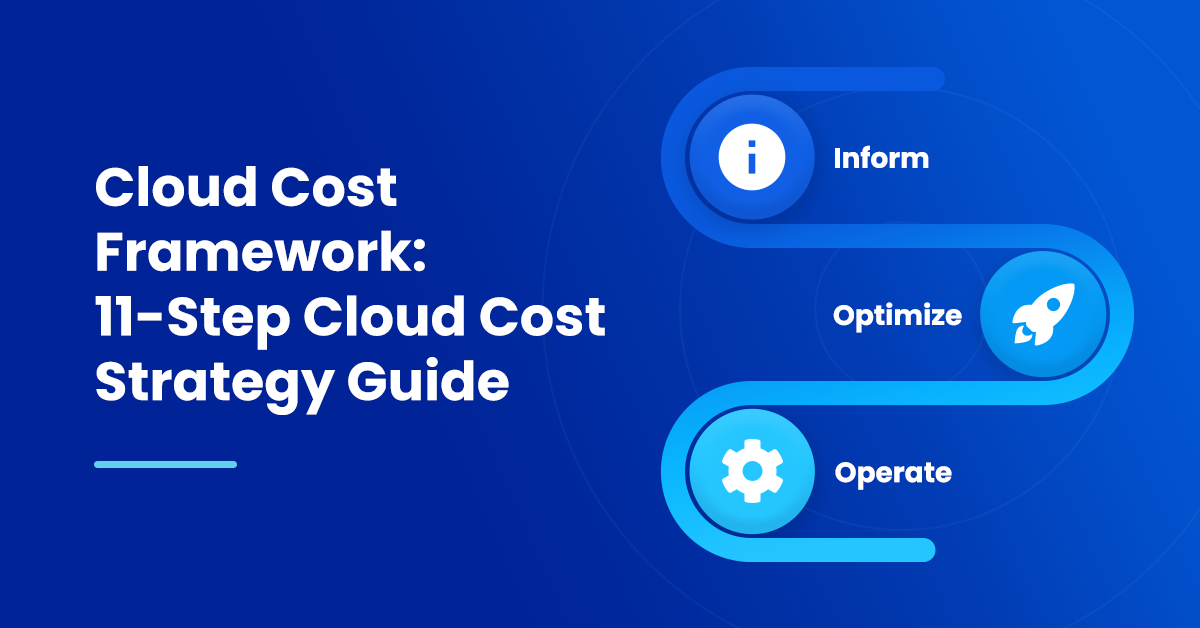A cloud cost framework allows you to analyze your cloud spending decisions and optimize them to cut down cloud costs as much as possible. It’s about rethinking whether you are spending the correct amount on cloud usage or whether you need to spend less.
The three major phases of the FinOps lifecycle make up the cloud cost framework: Inform, optimize, and operate.
Let’s take a look at each one of them in detail.
Inform
The inform phase aims to get more visibility into cloud cost allocation-you should be able to understand your overall cloud costs and what contributes to them. The phase lets you drill down gradually into cloud cost allocation and establish shared accountability across the organization.
It’s about more than understanding your cloud bill in an in-depth manner. It’s about adding visibility to your cloud spend and showing teams/ departments how much they spend on their cloud usage. People within the organization should see the impact of their actions on the cloud bill.
Here are the steps in this phase:
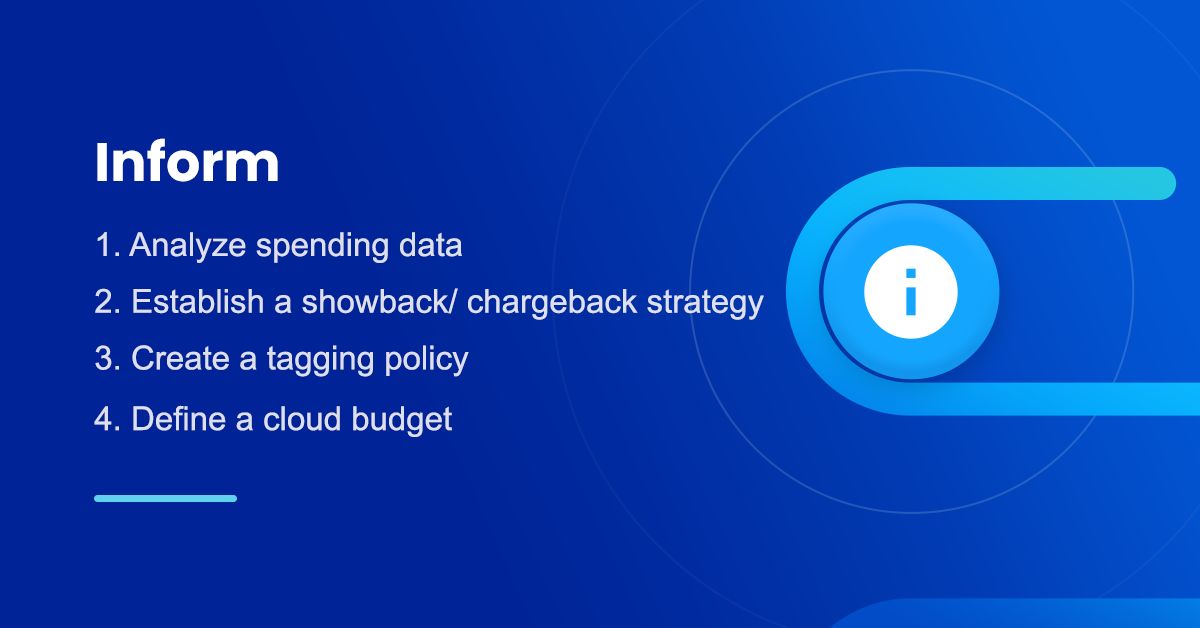
1- Analyze spending data
Start by looking at the past spending data for every business unit, department, application, and resource. You can only create an accurate cloud cost framework when you understand the existing cloud spend.
An excellent way to start is by looking at the monthly cost usage reports or breaking down your monthly cloud bills.
2- Establish a showback/ chargeback strategy
Implementing a showback or chargeback strategy can help you establish cloud spend accountability and ownership across different business units.
You can opt for showback or chargeback depending on how strict you want to be regarding cloud spend ownership.
While showback only shows departments how much they are spending on cloud usage, chargebacks actually charge departments based on their cloud usage.
Chargebacks are more complicated to implement since you would have to create a budget for every business unit based on their past usage and integrate chargeback reports with internal financial management tools. If not introduced in the right way, chargebacks can have a detrimental effect on employee morale and make employees feel like they are being penalized for just doing their work.
3- Create a tagging policy
The only accurate way to track the usage of every department or business unit is by adding tags to every resource through a well-established tagging strategy.
Having a tagging strategy that perfectly aligns with your account hierarchy also allows you to generate highly granular reports.
Your tagging strategy should also be able to identify untagged or mistagged resources. Without this, your tag sprawl may quickly end up making your tags unusable.
4- Define a cloud budget
Your cloud budget will be the main metric when you implement your cloud cost framework. That is why it is important you take your time when establishing your cloud budget. All the stakeholders should be involved in this decision-making process. Moreover, your cloud budget should be a realistic number.
Optimize
The optimize phase involves identifying cost optimization and cost avoidance measures. You track all the cloud usage and processes in real-time to optimize cloud usage.
Here are the steps involved in the optimize phase:
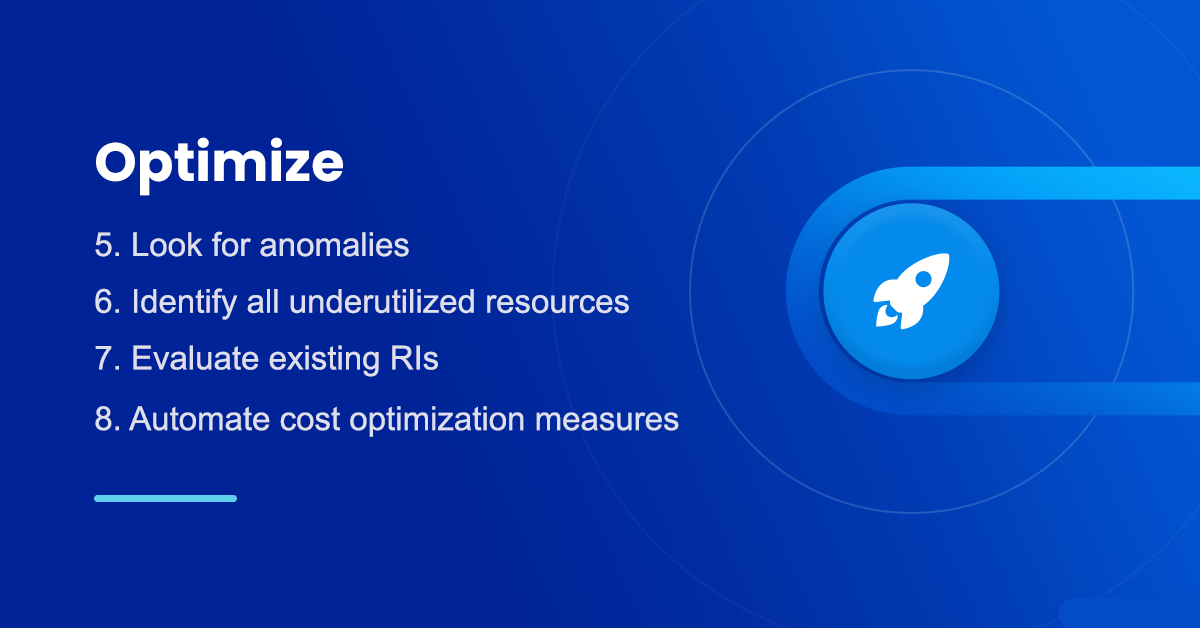
5- Look for anomalies
Detecting anomalies is about identifying unusual spikes in your overall cloud usage. By finding any big deviations like a sudden rise in cloud spend for a particular day of the week or a particular application, you can work to quickly remedy it before it can cause any long-term problems.
6- Identify all underutilized resources
AWS allows you to purchase resources in several sizes. Most users will end up purchasing large sizes of resources either because they aren’t sure of the correct size or because they just want to buy the largest server that fits their budget.
The result?
You end with excess capacity and underutilized resources. But AWS continues to charge you for the capacity whether you end up using it or not.
By identifying all the underutilized resources, you can significantly reduce your cloud bill and save up.
7- Evaluate existing RIs
Another way to optimize your cloud costs would be to evaluate all the KPIs and metrics for your existing AWS Reserved Instances (RIs) to ensure they are as effective as possible. When you are done evaluating, that’s when you should consider looking for new RIs to buy.
8- Automate cost optimization measures
After all, optimization can take up a big chunk of your team’s time and take them away from their primary responsibilities. That is why an important step of the cloud cost framework is automating cost optimization measures.
nOps is a fully automated AWS cloud management platform that can help reduce your AWS costs by over 50% on auto-pilot.
Here are some of the many ways nOps can help automate cost optimization measures:
- Automate tagging process and handle both untagged and mistagged resources to ensure every single dollar of AWS spend is correctly allocated
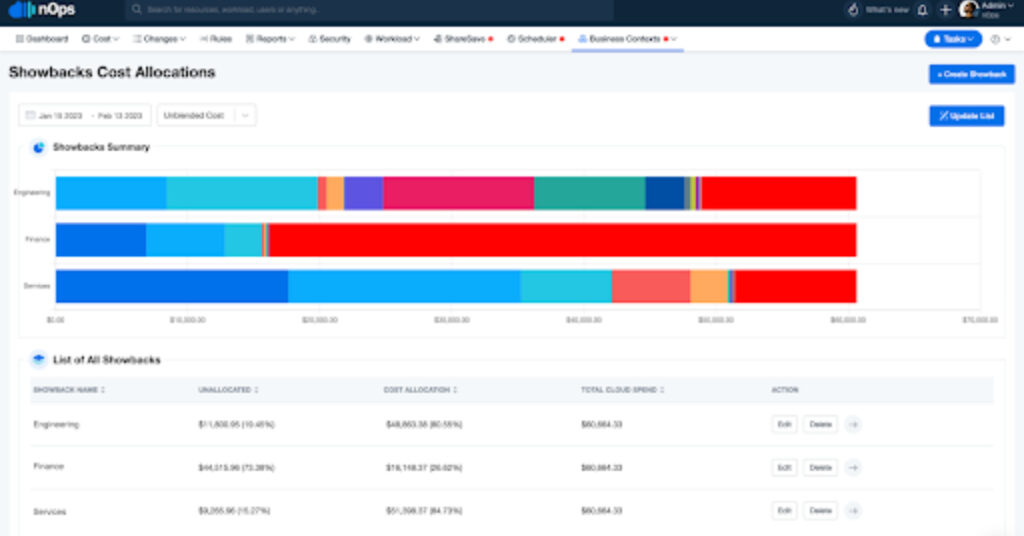
- Pause idle resources automatically by detecting their usage pattern.
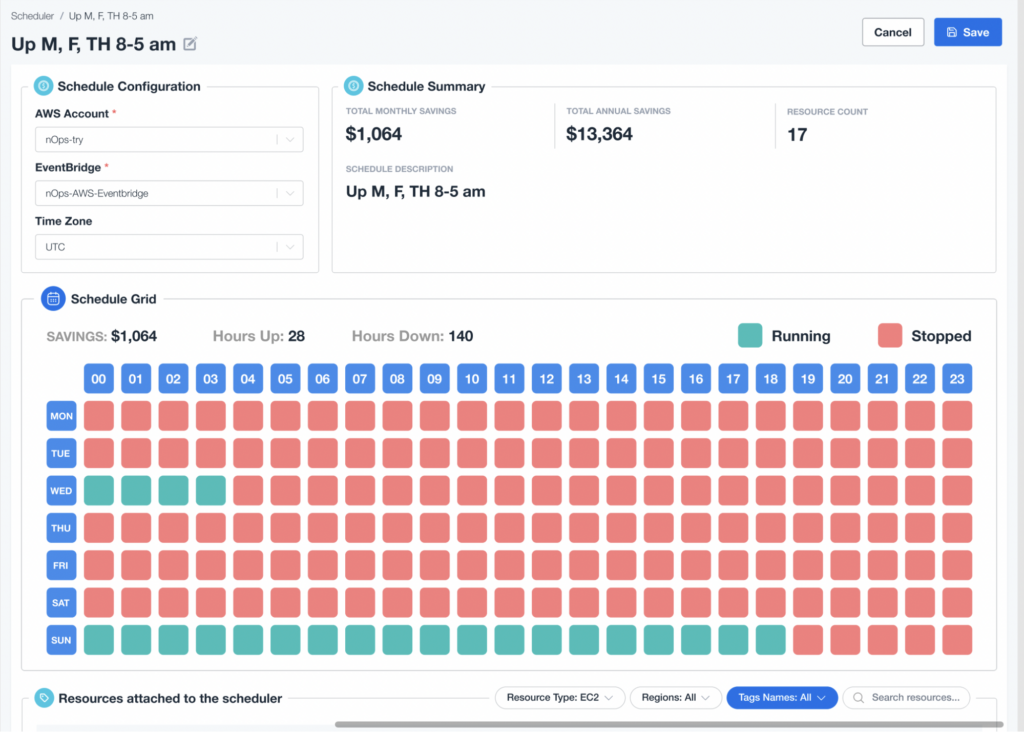
- Automatically sell and purchase RIs depending on your capacity changes.
- Rightsize by automatically detecting improperly sized EC2 instances and recommending the correct size to reconfigure them
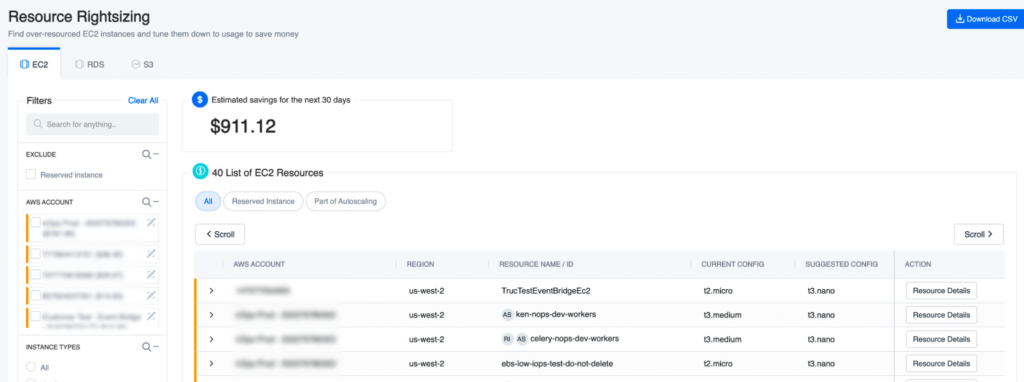
Operate
The operate phase involves putting your optimization steps into action. While your cloud cost goals have already been set, this is the phase where decisions and plans are put into place so that you can meet those goals.
Here are the steps that make up the operate phase:
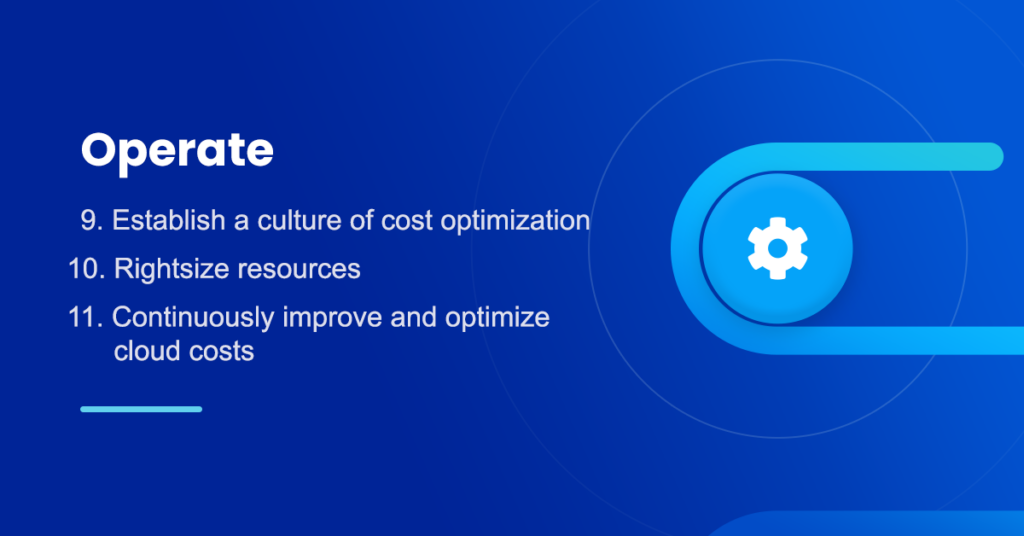
9- Establish a culture of cost optimization
You need stakeholder buy-in if you are serious about cloud cost optimization. Otherwise, your cloud cost framework will only end up being a lengthy document that no one cares to look at. Teams need to be educated and empowered about the importance of cost optimization.
You can also implement showback or chargeback models to increase accountability for cloud usage within teams or department units
10- Rightsize resources
The optimize phase may make you realize that you might be paying for more RIs and underutilized resources than you need. At this point, you should review the excess capacity to rightsize these resources and make changes accordingly.
For instance, you could replace unused storage space with smaller sizes or use less expensive instances. You can also reallocate underutilized resources to other departments that need increased capacity.
11- Continuously improve and optimize cloud costs
Cloud cost optimization has to be a continuous and iterative process where you constantly refine goals and targets to achieve business outcomes. After all, what works for your organization today, may not work three months down the line. You should constantly monitor key metrics to drive current and future optimization goals.
How nOps Can Help You Create An Effective Cloud Cost Framework!
nOps can cut down your cloud bills and automate the entire process of optimizing your cloud cost framework, so your team doesn’t have to worry about cloud usage or costs. It can help you achieve every step of the cloud cost framework by tracking, analyzing, and optimizing your cloud usage.
With nOps, you can analyze current spending data, implement chargeback/ showback tagging, identify underutilized resources, cut down on RI costs, rightsize instances, and more.
By adopting nOps, you can:
- Pay less for what you use
- Use less by pausing idle resources automatically
Let us help you save! Sign up for nOps today.

